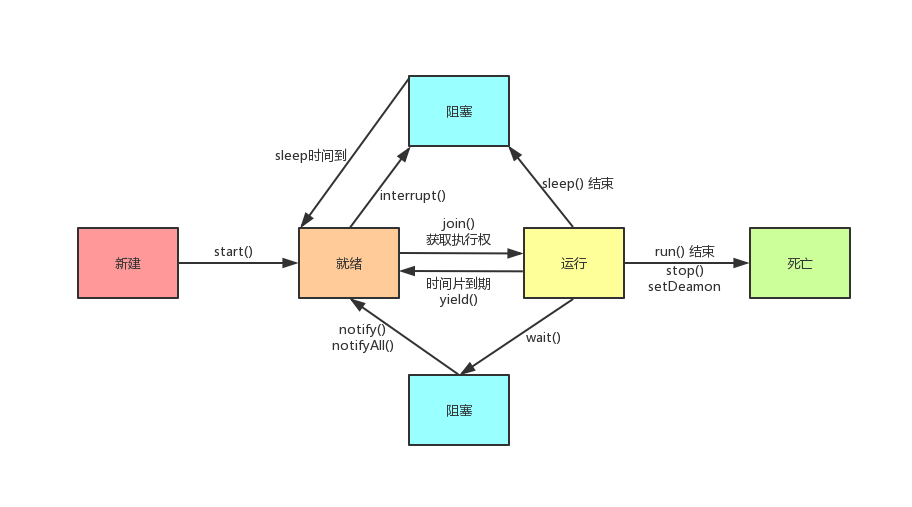Java-thread
1.背景
线程安全大多数时候很重要。
2.Thread
线程(英语:thread)是操作系统能够进行运算调度的最小单位。它被包含在进程之中,是进程中的实际运作单位。一条线程指的是进程中一个单一顺序的控制流,一个进程中可以并发多个线程,每条线程并行执行不同的任务。
(1)Thread 五种状态
新建状态:
使用 new 关键字和 Thread 类或其子类建立一个线程对象后,该线程对象就处于新建状态。它保持这个状态直到程序 start() 这个线程。
就绪状态:
当线程对象调用了start()方法之后,该线程就进入就绪状态。就绪状态的线程处于就绪队列中,要等待JVM里线程调度器的调度。
运行状态:
如果就绪状态的线程获取 CPU 资源,就可以执行 run(),此时线程便处于运行状态。处于运行状态的线程最为复杂,它可以变为阻塞状态、就绪状态和死亡状态。
阻塞状态:
如果一个线程执行了sleep(睡眠)、suspend(挂起)等方法,失去所占用资源之后,该线程就从运行状态进入阻塞状态。在睡眠时间已到或获得设备资源后可以重新进入就绪状态。可以分为三种:
等待阻塞:运行状态中的线程执行 wait() 方法,使线程进入到等待阻塞状态。
同步阻塞:线程在获取 synchronized 同步锁失败(因为同步锁被其他线程占用)。
其他阻塞:通过调用线程的 sleep() 或 join() 发出了 I/O 请求时,线程就会进入到阻塞状态。当sleep() 状态超时,join() 等待线程终止或超时,或者 I/O 处理完毕,线程重新转入就绪状态。
死亡状态:
一个运行状态的线程完成任务或者其他终止条件发生时,该线程就切换到终止状态。
(2)Thread 常用方法
| 方法名称 | 类型 | 描述 |
|---|---|---|
| public Thread(Runnable target) | 构造 | 接收Runnable接口子类对象,实例化Thread对象 |
| public Thread(Runnable target,String name) | 构造 | 接收Runnable接口子类对象,实例化Thread对象,并设置线程名称 |
| public Thread(String name) | 构造 | 实例化Thread对象,并设置线程名称 |
| public static Thread currentThread() | 普通 | 返回目前正在运行的线程 |
| public final String getName() | 普通 | 返回线程名称 |
| public final int getPriority() | 普通 | 返回线程的优先级 |
| public boolean isInterrupted() | 普通 | 判断目前线程是否被中断 |
| public final boolean isAlive() | 普通 | 判断线程是否在活动 |
| public final void join() throws Interrupted Exception | 普通 | 等待线程死亡 |
| public final synchronized void join(long millis) throws InterruptedException | 普通 | 等待millis毫秒后,线程死亡 |
| public void run() | 普通 | 执行线程 |
| public final void setName(String Name) | 普通 | 设置线程名称 |
| public final void setPriority(int newPriority) | 普通 | 设置线程优先级 |
| public static void sleep(long millis) throws InterruptedExeption | 普通 | 使目前正在执行的线程休眠millis毫秒 |
| public void start() | 普通 | 开始执行线程 |
| public String toString() | 普通 | 返回代表线程的字符串 |
| public static void yield() | 普通 | 将目前正在执行的线程暂停,允许其他线程执行 |
| public final void setDaemon(boolean on) | 普通 | 将一个线程设置成后台运行 |
(3)Wait 方法
wait()方法是Object类里的方法,当一个线程执行到wait()方法时,它就进入到一个和该对象相关的等待池中,同时失去(释放)了对象的机锁(暂时失去机锁,wait(long timeout)超时时间到后还需要返还对象锁),其他线程可以访问。
wait()使用notify或者notifyAll或者指定睡眠时间来唤醒当前等待池中的线程。
wait()必须放在synchronized block中,否则会在program runtime时扔出 ”java.lang.IllegalMonitorStateException“ 异常。
sleep()和wait()方法的最大区别是:
sleep()睡眠时,保持对象锁,仍然占有该锁
wait()睡眠时,释放对象锁。
wait()和sleep()都可以通过interrupt()方法打断线程的暂停状态,从而使线程立刻抛出InterruptedException(但不建议使用该方法)。
3.代码
1 | public class ThreadA extends Thread { |
1 | public class ThreadB extends Thread { |
1 | public class Application { |
4.总结
CRUD谁都会,为了写出优秀的代码,必须静下心来学习。